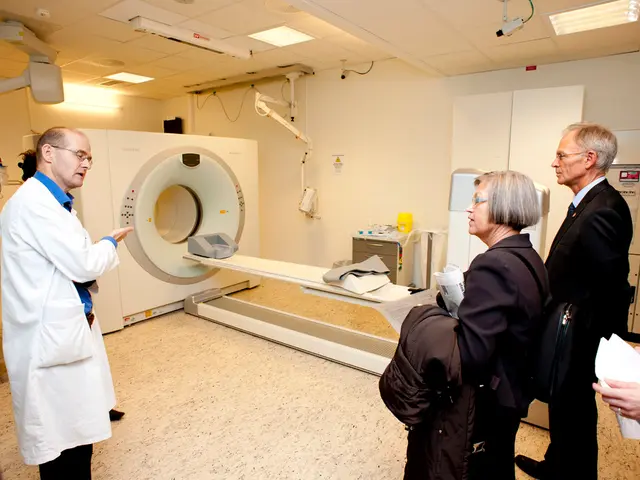Acupuncture Exploration: Function, Applications, Advantages, and Potential Hazards
In the realm of traditional Chinese medicine (TCM), health is believed to be maintained by the flow of a vital energy called *qi*, which circulates through channels known as meridians. One key component of TCM that aims to restore balance to this energy flow and alleviate symptoms, including chronic pain, is acupuncture [1][2].
## The Basis of Qi and Meridians
In TCM, *qi* is essential for maintaining health, and its flow can be disrupted by various factors, leading to disease. Acupuncture seeks to restore this balance by stimulating specific points along these meridians [1][2]. The 12 major meridians are linked to major organs in the body, and each plays a role in overall health. By targeting points along these meridians, practitioners believe they can influence the related organs and systems, promoting healing and balance [2].
## The Role of Acupuncture Points
Insertion of needles into acupuncture points is thought to stimulate the flow of *qi*, correcting imbalances that may contribute to chronic pain. This stimulation can either enhance or reduce *qi* flow, depending on the specific treatment goals [5]. Acupuncture points are often found along the meridians but can also include extraordinary points and *A-shi* points, which are not strictly located on meridians but are identified by tenderness or other diagnostic criteria. These points are believed to offer additional access to *qi* flow [1].
## Therapeutic Mechanisms
While the exact mechanisms are not fully understood from a Western perspective, acupuncture is believed to modulate pain perception by influencing neurological pathways and possibly affecting the release of endogenous opioids [5]. In TCM, emotions significantly affect *qi* flow and organ health. Techniques like acupuncture help regulate emotional responses, which can indirectly alleviate physical symptoms such as pain by promoting a balanced *qi* flow [4].
## A Holistic Approach
Acupuncture is often used in conjunction with other TCM methods, such as herbal medicine and mind-body exercises like qigong or tai chi, to enhance its effectiveness. These combined approaches aim to restore balance to both *qi* flow and overall health [4].
It is important to note that the Food and Drug Administration (FDA) regulates acupuncture needles as medical devices, and their manufacture and labeling need to meet certain standards. Possible risks of acupuncture are bleeding, bruising, soreness, infection, and in rare cases, a needle may break and damage an internal organ [3].
Acupuncture is a flexible form of treatment that can target numerous health concerns at once. It can be effectively combined with other treatments, making it a common complementary therapy that can help people manage many different conditions, such as nausea, rheumatoid arthritis, fatigue, tendinopathy, osteoarthritis (OA) in the knees, migraine, headaches, and low back pain [6][7].
Before undergoing acupuncture to treat chronic pain or other conditions, a person should seek advice from a primary care physician. Individuals will typically sit or lie down during the procedure, and the acupuncturist should use single-use, disposable, sterile needles. The number of treatments a person will need depends on their individual case, with chronic conditions requiring one or two treatments per week over several months, and acute health issues improving after 8-12 sessions [8].
References: [1] National Center for Complementary and Integrative Health (NCCIH). (2020). Acupuncture: In Depth. Retrieved from
- In the realm of traditional Chinese medicine (TCM), predictive health maintenance is believed to be governed by the flow of a vital energy called qi, which circulates through channels known as meridians.
- Diseases can form due to disruptions in the flow of qi, and acupuncture aims to restore balance by stimulating specific points along these meridians.
- Crohns, bipolar, type, macular degeneration, chronic migraine, and other conditions are potential targets for acupuncture treatment, as it can influence related organs and systems, promoting healing and balance.
- Prep for acupuncture treatments often involves sitting or lying down, and practitioners should use single-use, disposable, sterile needles for patient safety.
- Pain management is a common application of acupuncture, as it modulates pain perception by influencing neurological pathways and possibly affecting the release of endogenous opioids.
- The prevention and treatment of cancer, AQ, and other degenerative diseases are also explored in the context of acupuncture, given its ability to influence overall organ health and emotional responses.
- Mental-health conditions such as depression and anxiety can possibly be alleviated through acupuncture, as it helps regulate emotional responses that indirectly affect physical symptoms.
- Diabetes, HIV, and sinus infections are among the numerous health-and-wellness issues that can potentially be addressed with acupuncture therapies and treatments, given its versatility and effectiveness in managing symptoms.
- Science and research continue to investigate the mechanisms behind acupuncture, with a focus on understanding its role in promoting health and alleviating pain.
- Acupuncture services are regulated by the Food and Drug Administration (FDA) to ensure the manufacture and labeling of acupuncture needles meet certain standards.
- Dry conditions like eczema or psoriasis, and even complex health issues such as breast cancer, may benefit from acupuncture's ability to promote healing and reduce associated discomfort.
- Acupuncture is a complementary therapy that can be effectively combined with conventional treatments for a holistic approach to health and wellness, ensuring overall balance is restored.




